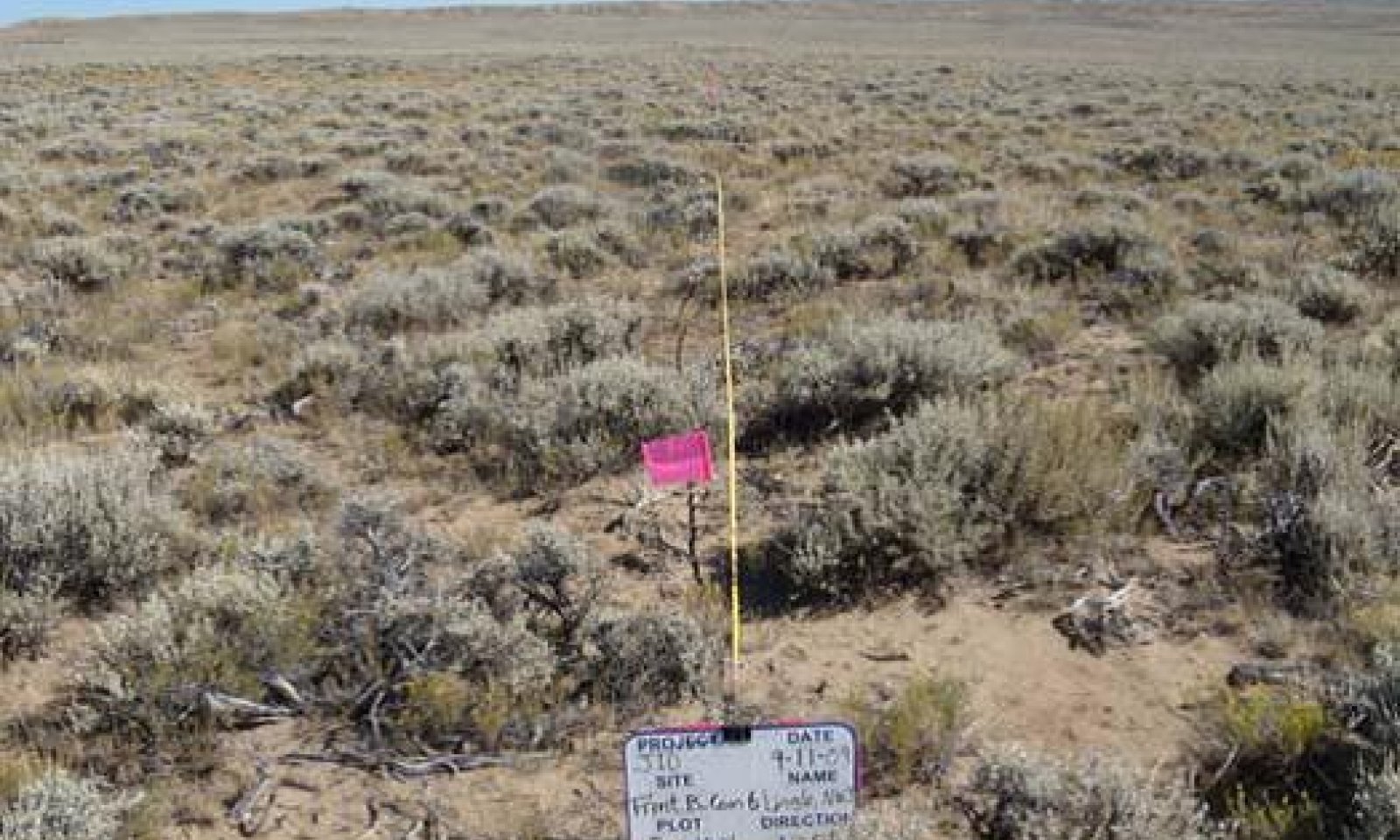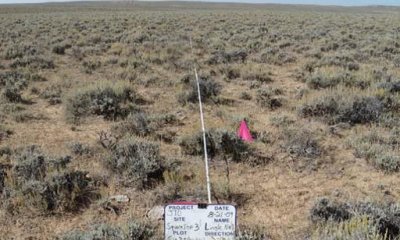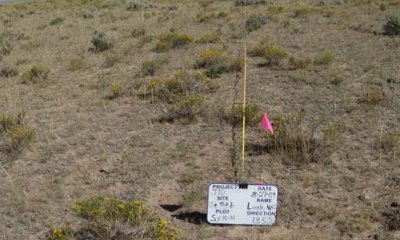
Sandy Pinedale Plateau (Sy PP)
Scenario model
Current ecosystem state
Select a state
Management practices/drivers
Select a transition or restoration pathway
- Transition T1A More details
- Transition T1B More details
- Transition T1C More details
- Restoration pathway R2A More details
- Transition T2A More details
- Transition T2B More details
- Restoration pathway R3A More details
- Restoration pathway R3B More details
- Transition T3A More details
-
No transition or restoration pathway between the selected states has been described
Target ecosystem state
Select a state
Description
The Reference State consists of three Plant Communities: the Big Sagebrush/Bunchgrass Community (1.1) the Bunchgrass/Big sagebrush Plant Community (1.2) and the Bunchgrass Community (1.3). Each community differs in percent composition of bunchgrasses and percent woody canopy cover. Forbs are a minor component on this site. Woody canopy cover is less than 25 percent.
Dominant shrub species is Wyoming Big Sagebrush in the Reference State (1), with some instances of, mountain big sagebrush at the upper end of the precipitation range.
Two important processes occurring in this state result in plant community changes within Reference State: sagebrush killing disturbances (browse, insects, drought, fire) and time without those disturbances. These processes are generally referred to as “natural succession.”
The shift from the Bunchgrass Plant Community (1.3) to the Bunchgrass/Big Sagebrush Plant Community (1.2) and subsequently to the Big Sagebrush/Bunchgrass Plant Community is dependent on an increase of woody cover. Without sagebrush killing disturbance, shrubs will increase on this ecological site even with proper grazing management. Improper grazing management may accelerate the rate of increase for woody species.
The shift from the Big Sagebrush/Bunchgrass or Bunchgrass/Big Sagebrush Plant Communities is dependent on sagebrush killing disturbances such as fire, drought, browse, and insects. Management actions can and are often used to mimic these processes through mechanical and chemical treatments. Prescribed fire is not often used on this site due to current land uses and lack of fuels and adequate burn windows.
Submodel
Description
The Grazing Resistant State (2) is characterized by an herbaceous layer dominated by short-statured bunchgrasses such such as Sandberg bluegrass and, rhizomatous grasses and grass-likes, and/or mat forbs such as Hood’s phlox, sandwort, and sulfur flowered buckwheat. Mid-stature bunchgrasses such as Indian ricegrass, needleandthread/, Letterman’s needlegrass, bluebunch wheatgrass, and bottlebrush squirreltail have become scarce or absent. There is one community in the Grazing Resistant State: the Big Sagebrush/Rhizomatous Wheatgrass-Sandberg Bluegrass -Mat Forb Plant Community (2.1).
The site crosses the threshold to the Grazing Resistant State (2) from the Reference State (1) when desirable mid-stature bunchgrasses lose dominance. Once the key species become scarce, it is unlikely that they have sufficient reproductive capability (seed source, tillering, or resprouting) to recover dominance in a reasonable time frame without extra energy being added to the system.
The Plant Community in the Grazing Resistant State (2) is very resilient and therefore common on Loamy sites in this MLRA. In many cases, the transition to the Grazing Resistant State (2) may have occurred many decades ago during an era of higher stocking rates and continuous grazing during the growing season. However, continual grazing during the critical growth period (roughly May-June) at proper stocking rates will facilitate the transition to this state and maintain it in a stable state. While dominance by rhizomatous grasses makes the return to the Reference State (1) plant community difficult, it also makes the site resistant to further degradation except in cases where overstocked or in the case of prolonged drought with full stocking. The main factor creating high resiliency of the Big Sagebrush/Rhizomatous Wheatgrass-Sandberg Bluegrass-Mat Forb Plant Community is that the bluegrass and rhizomatous grasses are highly grazing tolerant. Sandberg bluegrass and rhizomatous grasses are low to the ground, so, even under heavy grazing, enough biomass remains for the grasses to maintain plant vigor. Rhizomatous grasses successfully reproduce through underground rhizomes. The rhizomatous grasses can form mats that provide soil protection by protecting the soil from raindrop impact, decreasing the risk of soil erosion. However, overall soil health is lower than the reference state, primarily due to a reduction in soil organic matter due to a reduction in litter. The decreased infiltration is due increased bare ground patch size and lack of litter that acts as mulch in retaining soil moisture and retarding runoff. Under high intensity early season grazing, especially by in calving pastures and in small acreage horse pastures, ground cover decreases to a point that the site will transition to the Bare Ground State (3).
Submodel
Description
This state contains one community, the Big Sagebrush/Bare Ground Community (3.1). It is characterized by sparse herbaceous plant cover dominated by big sagebrush and bare ground.
Communities in the Eroded State (3) have crossed a threshold (T1B or T2A) because of soil erosion, loss of soil fertility, and/or degradation of soil properties. Soil erosion affects the hydrology, soil chemistry, soil microorganisms, and soil physics to the point where intensive restoration is required to restore the site to another state or community. Simply changing grazing management may not create sufficient change to restore the site within a reasonable period. It will require a considerable input of energy to move the site back to the Reference State (1).
The Eroded State (3.0) is at high risk of weed invasion due to the high percentage of bare ground. Many invasive species are adapted to low soil fertility, high soil temperatures and low soil moisture content. This puts the community at risk of transitioning to the Disturbed State (4).
Submodel
Description
This state is characterized by the amount of rabbitbrush invasion on the site. It also has a component of annual forbs and substantial bare ground.
Is occurs with multiple sagebrush killing events in rapid succession outside the normal disturbance regime for this site (see Reference State for discussion). It could be mechanical (including heavy equipment/construction or a mowing/chaining/harrow type sage treatment), chemical (including 2,4-D or tebuthiron), or biological (including browse and/or insects). Fire could be a factor in maintaining this plant community perpetually by stimulating sprouting shrubs (rabbitbrush) and killing sagebrush. This is usually only a concern annual weeds are prolific on the site during wet cycles that boost their production.
Removal of shrubs without proper grazing management can lead to an increase in bare ground and erosion of the upper soil horizon. Consequences of this are decreased soil fertility or even soil erosion, soil crusting, and decrease of soil surface aggregate stability.
Submodel
Mechanism
The driver for Transition T1-2 is continuous spring grazing and/or long-term drought.
Continuous spring grazing and/or drought can lead to a decline in palatable mid-stature bunchgrasses. Indian ricegrass, a short-lived perennial that requires more frequent seed production to provide an adequate seedbank, and bluebunch wheatgrass, a long-lived perennial that has elevated growth points, are typically the first species to decline (Natural Resources Conservation Service). Needleandthread as well as Letterman’s needlegrass are more grazing tolerant, but will eventually decline in plant density and vigor. As bunchgrasses diminish or die during periods of stress, low- stature bunchgrasses and rhizomatous grasses gain a competitive advantage, creating a shift in species composition towards less productive, shorter species. While bare ground may not change, the pattern of bare ground will shift to larger gaps in the canopy and fewer herbaceous plants between shrubs. Many of the remaining desirable bunchgrasses will be only found in the understory of the sagebrush canopy.
Once mid-stature bunchgrasses species become scarce, it is unlikely that they have sufficient reproductive capability (seed source, tillering, or resprouting) to recover dominance in a reasonable time frame without extra energy being added to the system. When the understory vegetation has been degraded to this point, the transition to the Grazing Resistant State (2) can occur from either the Bunchgrass/Big Sagebrush Plant Community (1.2) or the Big Sagebrush/Bunchgrass Plant Community (1.1). The transition is not dependent on the increase of woody canopy cover, but rather on the lack of mid-stature bunchgrasses in the canopy interspaces.
Management should focus on grazing management strategies that will prevent further degradation. This can be achieved through a grazing management scheme that varies the season of use to provide periodic deferment during the critical growth period (roughly May-June). Forage quantity and/or quality in the Grazing Resistant State (2) may be substantially reduced compared to the Reference State.
Mechanism
The driver for Transition T1-3 is continuous high intensity early season grazing and/or long-term drought.
The Reference State (1) transitions to the Eroded State (3) if plant canopy cover declines significantly or total annual aboveground biomass production falls below 400 pounds per acre. The trigger for this transition is the loss of understory, which creates open spots with bare soil. Soil erosion is accompanied by decreased soil fertility driving the transitions to the Bare Ground State. Several other key factors signal the approach of transition T1B: an increase in soil physical crusting, a decrease in soil surface aggregate stability, and/or evidence of erosion, including water flow patterns, development of plant pedestals, and litter movement.
Mechanism
The driver for this transition is an increase in the disturbance cycle (i.e. grazing, drought, fire, mechanical, chemical or biological treatments) often in combination with grazing management that does not provide periodic deferment during the critical growth period.
The Reference State (1) may transition to the Disturbed State (4) if a soil disturbing activity has occurred to encourage aggressive invasive species, such as cheatgrass, are introduced with an increase in rabbitbrush due to ground disturbance that could be either natural (i.e. water movement) or manmade (i.e. high density/high frequency stocking, mechanical treatments or heavy equipment operations). To prevent this transition, the site will require proper reclamation using the most current science and technology available to restore native vegetation and prevent invasive dominance. In some instances, it may not be possible to prevent this transition. In cases where total topsoil loss occurs, it may be unavoidable to prevent this transition.
Long-term stress conditions for native species (e.g., improper grazing management, drought, and fire) will alter plant community composition and production over time and may hasten a transition to the Disturbed State (4). The resulting lower biomass production, reduced litter, and increased bare ground in this community can promote invasion of undesirable species. The site transitions to the Disturbed State when populations of invasive species reach critical levels.
Mechanism
The drivers for this restoration pathway are removal of woody species and restoration of native herbaceous species by mechanical or chemical treatment of sagebrush, and grazing rest or deferment. If some mid- stature bunchgrasses remain under the sage canopy, proper grazing management can move the site back to the Reference State (1) combined with a mechanical or chemical sagebrush treatment. This could take multiple generations of management or could be accelerated with rest or deferment combined with successive wet springs conducive to seed germination and seedling establishment. (Derner, Schuman, Follett, & Vance, 2014)
Mechanism
The driver for this transition is continuous high intensity early season grazing. Examples include calving pastures and small acreage horse pastures where rotational grazing is not employed. Extended drought period may provide a trigger to accelerate this process.
This state is typified by old age sagebrush stands with very little herbaceous understory. Bare ground patch size has increased to the majority of the interspaces between sagebrush plants
Mechanism
The driver for this transition is an increase in the disturbance cycle (i.e. grazing, drought, fire, mechanical, chemical, biological treatments).
Removal of shrubs without proper grazing management can lead to an increase in bare ground and erosion of the upper soil horizon, and the site can degrade to the Disturbed State (4). Consequences of this transition are decreased soil fertility or even soil erosion, soil crusting, and decrease of soil surface aggregate stability
Mechanism
This state has lost soil or vegetation attributes to the point that recovery to the Reference State will require a combination of grazing management (changing season of use to allow frequent rest or deferment during the critical growth period) and chemical, biological or mechanical treatments, and reseeding. Seeding may become cost prohibiting as a restoration practice used alone. With reduced organic matter and loss of soil, soil amendments may be needed to have a successful seeding.
Mechanism
The drivers for this restoration pathway are mechanical, biological and chemical treatments with only temporary rest or deferment post-treatment. Due to loss of soil fertility, structure, and organic matter, reference community plants are slow to repopulate the site. Success of this restoration is highly dependent upon climatic factors
Mechanism
The driver for this transition is multiple sagebrush killing events in rapid succession outside the normal disturbance regime for this site (see Reference State for discussion). It could be mechanical (including heavy equipment/construction or a mowing/chaining/harrow type sage treatment), chemical (including 2,4-D or tebuthiron), or biological (including browse and/or insects). Fire is not usually possible due to lack of understory fuels to carry the fire. In fact, the Eroded State is characterized by monotypic decadent sagebrush stands because they are fireproof.
Model keys
Briefcase
Add ecological sites and Major Land Resource Areas to your briefcase by clicking on the briefcase (![]() ) icon wherever it occurs. Drag and drop items to reorder. Cookies are used to store briefcase items between browsing sessions. Because of this, the number of items that can be added to your briefcase is limited, and briefcase items added on one device and browser cannot be accessed from another device or browser. Users who do not wish to place cookies on their devices should not use the briefcase tool. Briefcase cookies serve no other purpose than described here and are deleted whenever browsing history is cleared.
) icon wherever it occurs. Drag and drop items to reorder. Cookies are used to store briefcase items between browsing sessions. Because of this, the number of items that can be added to your briefcase is limited, and briefcase items added on one device and browser cannot be accessed from another device or browser. Users who do not wish to place cookies on their devices should not use the briefcase tool. Briefcase cookies serve no other purpose than described here and are deleted whenever browsing history is cleared.
Ecological sites
Major Land Resource Areas
The Ecosystem Dynamics Interpretive Tool is an information system framework developed by the USDA-ARS Jornada Experimental Range, USDA Natural Resources Conservation Service, and New Mexico State University.







